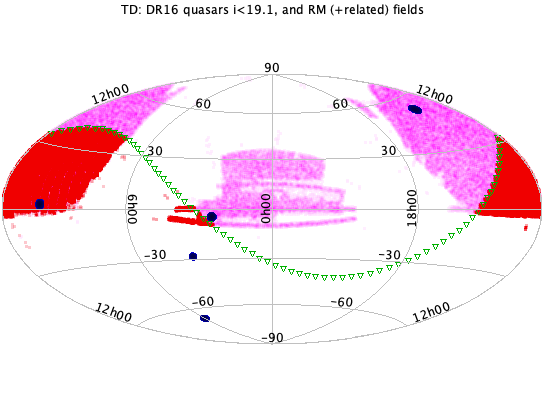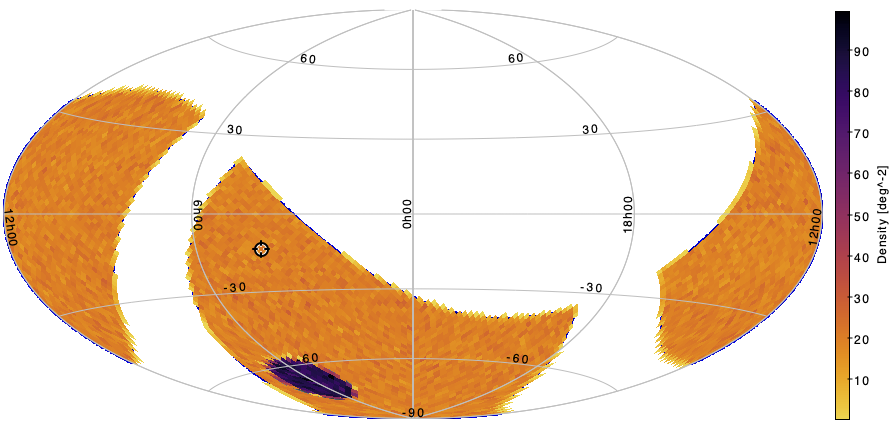Summary of BHM Time-Domain Spectral Programs
The BHM optical (BOSS) repeat spectral time-domain programs emphasize the astrophysics of quasars, including studies of BH masses, binarity, accretion and events, broad line region (BLR) dynamics, outflows, etc., requiring spectral sampling at a broad range of timescales/cadence, ranging from days to decades; this is achieved via several tiers.
AQMES (All-Quasar Multi-Epoch Spectroscopy)
The AQMES core program includes both a wide-area and low-cadence tier, and a modest-area and modest cadence tier, adding new epochs in SDSS-V to quasars/AGN also with at least one previous epoch of SDSS I to IV spectra, e.g., selected mainly from the DR16 quasar catalog (Lyke et al., 2020) :
- AQMES-WIDE: For >20,000 quasars, ≧ 2 epochs will be added during SDSS-V, and combined with earlier-epoch SDSS spectra, sampling ~1-10 yr timescales, e.g., to probe the BLR dynamics of the most massive BHs, statistics of changing look quasars, broad absoprtion line (BAL) disappearance/emergence, etc. (this is a wide area, but low-cadence time-domain tier; ≳2000 deg2).
- AQMES-MEDIUM: For >2000 quasars, ~10 epochs added in SDSS-V, probing down to ~1-month to 1-year timescales, adding unfolding BLR structural and dynamical changes (a medium tier in area and cadence; ≳200 deg2).
In addition, non-core programs will repeatedly observe fainter QSOs within the dedicated AQMES-Wide and AQMES-Medium fields, as well as opportunistically targeting known QSOs outside of that area, where fiber-resources permit.
For more details please see the dedicated AQMES page.
RM (Reverberation Mapping)
- Reverberation Mapping (RM; another core BHM program) aims — for >1000 quasars in 4-5 dedicated fields — to obtain optical (BOSS) repeat spectra with a high-cadence of >102 epochs, sampling down to days to weeks. The lags between the continuum and BLR emission yield BH masses, advancing RM measures to a broad range of luminosity and redshift (a small area, but high-cadence tier; ~30 deg2).
For more details please see the dedicated Reverberation Mapping page.
| Tier | No. of ~15 min BOSS exposures per epoch (mag limits) | Approx no. of epochs to be obtained | Approx. no. of fields | Approx. total no. of targets |
|---|---|---|---|---|
| AQMES WIDE | 4 (i<19.1) | >2 | ~400-600 (mainly North) | ~20,000 |
| AQMES MEDIUM | 4 (i<19.1) | >10 | ~35-60 (mainly North) | ~2000 |
| RM | 8 (i<~21) | ~174 | 4-5 (North+ South) | ~1000 |

Summary of BHM X-ray Source Counterpart Follow-up Programs
BHM optical (BOSS) spectroscopic follow-up of X-ray sources include a large core program (SPIDERS) relying on eROSITA X-ray data , and a more modest program relying on Chandra archival X-ray data.
SPIDERS (SPectroscopic IDentfication of ERosita Sources)
The main goal of the core SPIDERS (more formally the SPIDERS II) program is to provide a complete and homogeneous optical spectroscopic followup of X-ray sources (both point-like and extended) detected by eROSITA (in ~ 10,000 deg2 at high-Galactic latitude, within the German or ‘DE’ half of the sky). SPIDERS uses X-ray data from eROSITA’s first 1.5 years of operation, which began in 2019 (emphasizing eFEDS mini-survey spectroscopic follow-up in DR18, and eRASS:3 all-sky follow-up data later in SDSS-V).
- SPIDERS in BHM in its wide-area survey, utilizing data through eRASS:3 (first 3 eROSITA all-sky scans), aims to obtain the optical spectroscopic identifications and redshifts, evolution, and astrophysics of ~300,000 X-ray source counterparts, especially AGN (but also including ~104 X-ray emitting clusters of galaxies, and X-ray emitting stars).
- This program (beginning in SDSS-IV and finishing in SDSS-V) has largely completed BOSS spectroscopy for ~104 candidate counterparts in the eFEDS mini-survey (140 deg2) region of the sky, and these BHM/SPIDERS optical spectra in eFEDS are a centerpiece of the DR18 data release.
There are also several SPIDERS-driven non-core programs, primarily intended to expand the footprint of the SPIDERS survey area, and implemented by exploiting somewhat lower quality optical imaging data.
| Component | No. of ~15 min BOSS exposures per epoch (mag limits) | Approx no. of epochs to be obtained | Approx. no. of fields | Approx. total no. of targets |
|---|---|---|---|---|
| SPIDERS (main) | 3-4 (i<21.5) | ~1 | ~600 (N) + ~2800 (S) | >250,000 |
| eFEDS | ~4 (i<21.5) | ~1 | ~37? (equatorial) | >10,000 |

For more details please see the dedicated SPIDERS page.
CSC (Chandra Source Catalog)
A related, more modest, program of mainly optical (BOSS) spectroscopy of X-ray counterparts (but including some IR APOGEE spectra as well), involves tens of thousands of X-ray source counterparts selected from the Chandra Source Catalog.
For more details please see the dedicated CSC page.
BHM Ancillary programs
In order to usefully use spare BOSS fiber-hours, the BHM team have devised two filler programs, targeting optical/IR selected QSOs and low redshift galaxies. These are described in more detail on the Ancillary Programs page.
